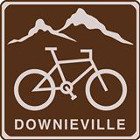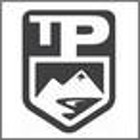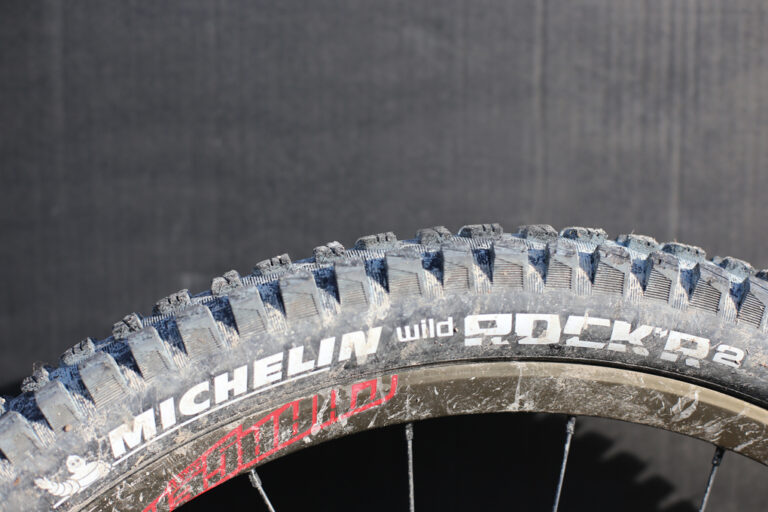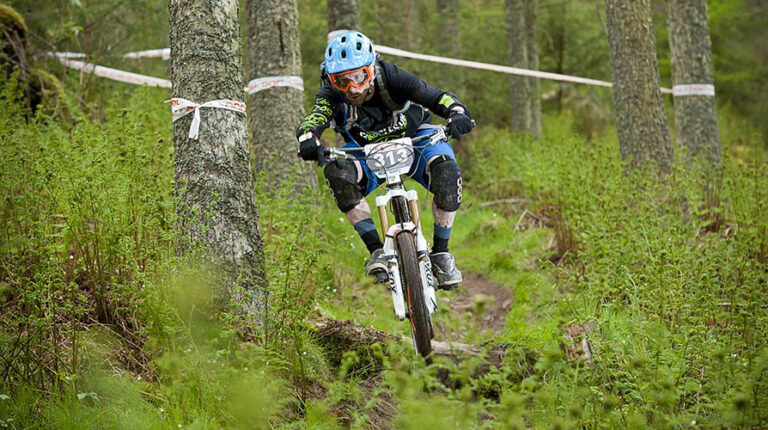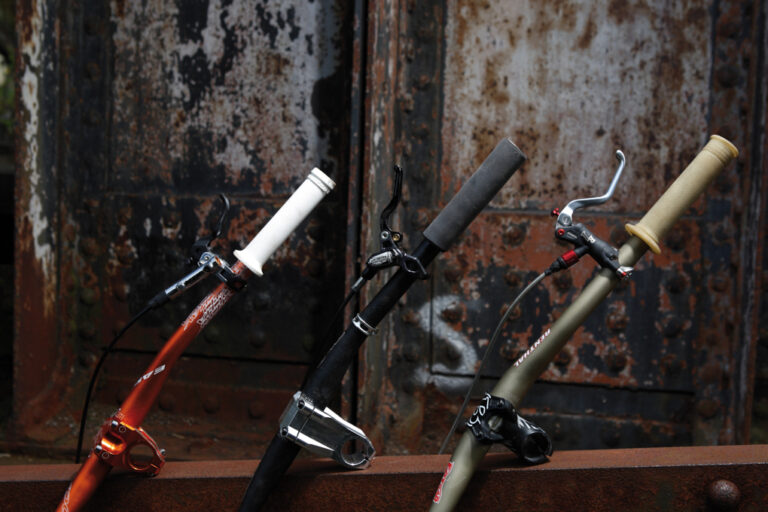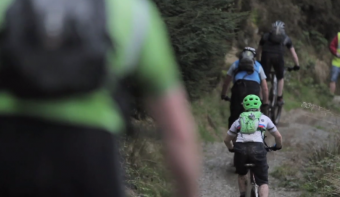
Mountain of hell
Locations/Dates: Les 2 Alpes 15–17th July
Price: €68
Details: www.les2alpes.com2010 Winner: Olivier Giordanengo 39mins 40sec
Description: This three day event has a drop in altitude of more than 2500 metres. There are 25km of downhill on an unmarked route passing through several timing posts, riding over snow, rocks, singletracks, steps and sheer descents. The final day culminates with the descent from 3400m to 900m forming the notorious race.
Rider’s view: The Mountain of Hell Episode 11What would it be like to race through almost every terrain imaginable against 443 other riders when you could only practice half the track? Last year riders were only allowed to walk some of the track which left a completely blind run for the race – and that bit was a glacier with a flat out 1km straight with an icy stream running across it – just before a fast right hand turn. You get up at 6:30am to get a train underneath a glacier up to an altitude of 3400m and wait for the race to start at 9:00 with a Le Mans style running start on the glacier. The race went through a pub, but you couldn’t stop for a drink because you were kind of in the middle of something. But then I guess (if you didn’t quit) the race finished down at 900m and a nice French lady poured chartreuse down your neck and sent you on your way? The Mountain of Heaven?
 The day before this main event you have to contend qualifying and if you’re lucky enough will be allowed to practice the whole track, there’s only one off–camber patch of snow to deal with and just 99 other riders in each heat. The track’s shorter too at around 24 minutes for the fastest, but no less enduro. Every couple of minutes the scenario is changing; shale, rocky outcrops, hardpack berms, massive rocks, alpine meadow and woods. It’s beautiful but the race pace is intense with everyone desperate for a spot near the front of the main event. The last 2km is on tarmac road and can get a bit ‘Tour de France’ but well…that’s ‘The Mountain of Hell’.
The day before this main event you have to contend qualifying and if you’re lucky enough will be allowed to practice the whole track, there’s only one off–camber patch of snow to deal with and just 99 other riders in each heat. The track’s shorter too at around 24 minutes for the fastest, but no less enduro. Every couple of minutes the scenario is changing; shale, rocky outcrops, hardpack berms, massive rocks, alpine meadow and woods. It’s beautiful but the race pace is intense with everyone desperate for a spot near the front of the main event. The last 2km is on tarmac road and can get a bit ‘Tour de France’ but well…that’s ‘The Mountain of Hell’.
STAGED DH ENDURO RACES
 Superenduro
Superenduro
Locations/Dates: Sestri Levante 16/17 April/Limone Piemonte 2/3 July/Sauze d’Oulx + Enduro of the Nations 6/7 August/Punta Ala 17/18 September/Finale Ligure 22/23 October
Price: €30
www.superenduromtb.com DescriptionSuperenduro is characterized by up to six stages between two and fifteen minutes long specifically ‘tuned’ by the team. Don’t be misled by the slightly laid back philosophy because it’s definitely flat out, “The main goal of the Superenduro philosophy is to create a universal racing format, accessible by every mountain biker without the need to purchase any special equipment other than the bike he/she uses every weekend, which at the same time is challenging enough even for professionals. It awards the most well–rounded riders who possess the skills to ride fast in the Special Stages and to cover the Transfer Stages efficiently and within the imposed time limits.”
Rider’s view Al StockThe San Remo rally has been held since 1928, drivers race through a technical ribbon of tarmac lined with rally fans at 130 mph+ (teams use speed limiters to stop the drivers going balls out). Last year I raced the final round of the series held a few miles down the coast in Finale Ligure. Riders race through diverse mountain tracks at sub 100 mph and there are no speed limiters, so you can go nuts. The 34km course opens for practice on Friday and comprises of five super special stages from the 50 second night prologue to a full–on enduro test of over 7 minutes. Kona’s Karim Amour took the overall win last year with 23mins 7secs. Stages are mostly linked by tarmac road and quite easily climbed, although the heat can be a factor bearing in mind you have to wear your helmet at all times, a lot of people take a half and a full face helmet carrying one on their back.
“Before Enduro in its different interpretations, there was a ‘hole’ in the racing scene”. Now into its fourth season Italy’s Superenduro series is already getting full–house entries. An interview with series organizer Enrico Guala Dirt: What do you get for 30 Euros?
Dirt: What do you get for 30 Euros?
Enrico: Let me see if you answer yourself at the end of the interview.
A mainly Italian entry? How many?Yes of course. We started the Superenduro with the goal to give the enduro bikes a racing format so we could sell more bikes and have more people at the races. Superenduro is a group of people who operates on the national market and distributors, reps, press, photographers and Italian riders were the initial goal for us.
You have to start from the ingredients you have and we have a lot of Italian riders in Italy. In 2010 an average 250 riders per race. But 2011 began in San Bartolomeo with 400 entries. The first year we had races with 50 riders and we tried not to give up, even if it was pretty sad to be honest. But even less than 50 riders are important when you start something new and we treated them as if they were World Champions, they have spread the word and now they come with friends.
Why not so many French in the results?In the beginning we went to see Tribe Sports Group, the Enduro Series organizers, because we wanted to team with them, but we were too young and they were not ready to risk with us. Even in terms of format we wanted to develop the ‘Italian way of Enduro’ while their Enduro format is different and there was no way to change it.
 Year after year they started to come to our events and we gained their trust. It became evident that there are different interpretations of the Enduro racing concept in Europe. It’s a matter of culture, MTB history of each country. Last year at the Enduro of Nations in Allos we participated with three ‘Italian’ teams, it became evident that there is not only one single interpretation of Enduro and I’m glad the organizers of the Enduro Series decided to move the Enduro MTB Trophy of Nations to a more International level and with the format of the hosting country. It is a big step for Enduro style of racing. It was not easy for Italians to gain the French confidence, but I’m glad we did and I’m sure EMTN 2011 will be a big weekend for Enduro worldwide.
Year after year they started to come to our events and we gained their trust. It became evident that there are different interpretations of the Enduro racing concept in Europe. It’s a matter of culture, MTB history of each country. Last year at the Enduro of Nations in Allos we participated with three ‘Italian’ teams, it became evident that there is not only one single interpretation of Enduro and I’m glad the organizers of the Enduro Series decided to move the Enduro MTB Trophy of Nations to a more International level and with the format of the hosting country. It is a big step for Enduro style of racing. It was not easy for Italians to gain the French confidence, but I’m glad we did and I’m sure EMTN 2011 will be a big weekend for Enduro worldwide.
We usually set a time/elevation ratio that may vary upon the type of climb, dirt or asphalt, and grade. Usually it’s one hour for 500m elevation. But we also evaluate weather and climate as variables. Thanks to our system we can adjust timing up to 5 minutes before the start of the first rider. There is a wide range of riders at Superenduro, pro to amateur, young kids (starting at 14) to ‘grey hair riders’. We need to find a balance. In the beginning 100% were able to make the deadline, now we are around 80% and we will set it to 70%.
Superenduro is not just a collection of downhill sections? No, you are right. Superenduro is about doing a ride with your friends on beautiful trails, with food along the ride, medical and safety assistance, but into a racing mode. Is it not what we have been doing since the beginning? Climbing to the top in a beautiful landscape to have fun on the way down on great singletrack and beat our friend.
No, you are right. Superenduro is about doing a ride with your friends on beautiful trails, with food along the ride, medical and safety assistance, but into a racing mode. Is it not what we have been doing since the beginning? Climbing to the top in a beautiful landscape to have fun on the way down on great singletrack and beat our friend.
But there is more, you need to work on the bike choice and set–up depending on your characteristics. You want a lighter bike if you are a stronger downhiller to save on the pedalling sections or a heavier and beefier bike if you are stronger on the climb and sprint, same for wheels, tyres and all other parts. There is no ‘perfect’ Superenduro bike, but the bike that fits you and the course better. And this is fun for the riders. Plus you have checkpoints where you need to show up at the given time like enduro on a motorcycle. Plus such a variety of times on the downhill sections…some short, some long.
Tell us a bit more about tuning?Each race we interpret what the location has to offer to bikers. On the Alpine events we can have lifts and a lot of vertical drop, because we can combine lift plus pedalling up. On the coast (like in Finale Ligure or Tuscany) we ride on very old trails of miners or farmers, like in Molini di Triora. We love Italy and Superenduro is a good way to let bikers discover the variety of trails, landscapes, perfumes, languages and food of our beautiful country.
Tuning also means deciding the time you need to be on top of the hill for the stage start, we can ‘tune’ a race more on the physical side or more on the riding, eventually we can reduce timing to the point that a 6″ bike with 66° head angle can’t make to the top in time unless pedalled by Absalon (Julien) or give enough time that you can go to the top walking and pushing a DH bike. This is the intriguing factor of Superenduro.
 Is there a format in terms of stage times that you follow?
Is there a format in terms of stage times that you follow?
No, there is no unique format. Once again we ‘read’ the location. There are races with 15 minutes stages, others with climbs up to 30 seconds. For each location we try to find the Superenduro ‘key’.
You need to be a complete rider?I think I’ve already answered this question, but the most important thing is that you need to love mountain biking and racing.
How long has the series been running?2011 is the fourth year. The arena is special, based in and around towns.
Quite important for sponsors?I would say it’s important for the riders, loud music, public, lights. It’s like racing in Monte Carlo F1. I tell you a story. The first time we did the arena stage in Finale Ligure the riders had been using my shoulder to clip–in both pedals for the start. You cannot imagine that even the top riders were trembling like kids to their first day of school. Plus we bring a good show downtown and the local people love it.
The sport is growing. American Super D, French Enduro series, Superenduro and now Gravity Enduro in UK. Is there a slow but steady shift of focus underway in competitive mountainbiking away from the traditional XC and DH? Mountain biking is a relatively young sport, about 30 years old, and it’s coming to maturity. The technical evolution of bikes and components has opened up a new way of riding and racing.
Mountain biking is a relatively young sport, about 30 years old, and it’s coming to maturity. The technical evolution of bikes and components has opened up a new way of riding and racing.
There is a bike category that is fun to ride and less engaging than modern XC or a DH bike. What would you buy if you can only have one bike and you like pedalling and going down fast? As the market changes the racing has to change too. Before Enduro in its different interpretations, there was a ‘hole’ in the racing scene.
I would not say the change is slow, things are moving pretty fast here. France and Italy lead the European Scene, the UK is coming. I still see Germany far away, I’m sure that they would love the Superenduro format, having talked to the few German riders who came to race in Italy. The USA is a different story because they developed Super D with riders in mind, instead of bikes. And another very important factor is that the first ‘Enduro’ bikes came from European brands that developed them for the Avalanche style of riding, again a European format.
Last year’s top three came from a variety of backgrounds, both downhill and cross country?Yes, but at the same time we have seen the birth of specialised Superenduro riders, fast on the way down with good fitness to do the climb fast and have the time to rest on top and still have power to sprint into the stages.
Enduro of Nations (EMTN) in Italy this year!It will be in Sauze d’Oulx–Alpi Bike Resort on August 6–7. Superenduro format with mass start for the last stage from top of the Fraiteve mountain down to the heart of the village. Two days of racing up and down in one of the most natural bike resorts we have in Italy. It’s the first time outside of France and we wish that the EMTN will start to move around the world like the Motocross of the Nations after this year.
 What are the challenges currently facing the sport of enduro?
What are the challenges currently facing the sport of enduro?
Rules first of all, there are many different interpretations of Enduro racing but if we want to achieve an International level we need to work on common rules.
Budget for the race organization. An event with three to four stages is almost like doing three or four DH races at the same time. You need timing, marshals, medical assistance, food and water, services, all at the same time on the separate tracks. There are a lot of personnel involved. The last risk is to put everything that is not XC or DH under the name of Enduro. This can be good, but also dangerous. In the beginning of a new sport you need to do things right, avoiding disappointing new riders. Every weekend of racing has to be an experience for the rider.
Where you going to take this sport?In Italy it’s mostly road racing and XC racing, biking generally means getting tired pedalling. Heart rate monitors, special food (I’m not saying illegal food)), lycra, shaved legs, but most of all water bottles. The water bottle is the big difference in attitude. When you leave the water bottle and switch to the backpack you change your mind and attitude. You become a potential Superenduro racer. To really be honest we have started Superenduro to support bike and accessory sales, but we understood the potential is huge! And now we are super–focused on the development of the discipline. I would love to see a Superenduro World Cup in the years to come, but the format will be super–important.

 Superenduro
Superenduro 